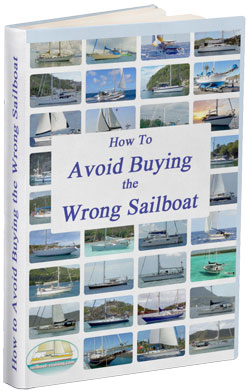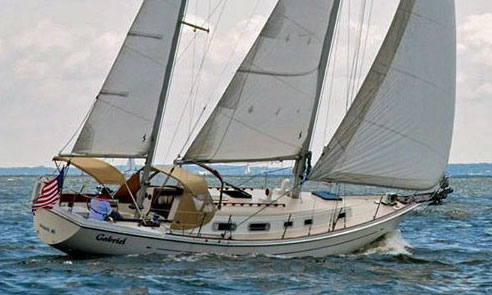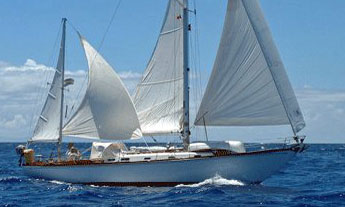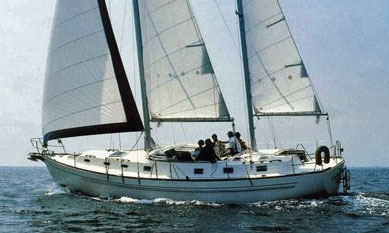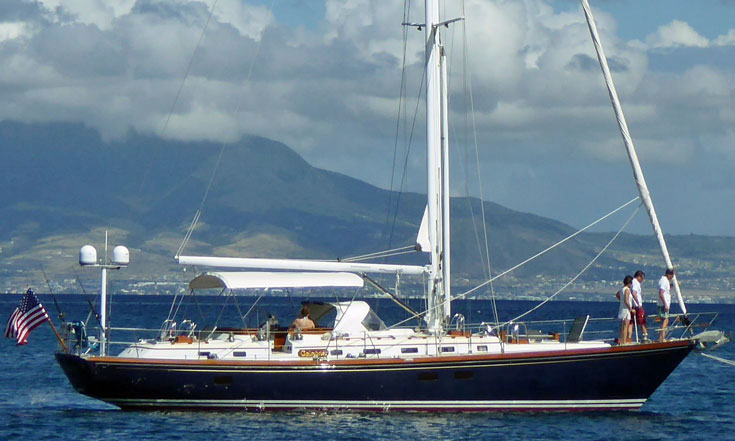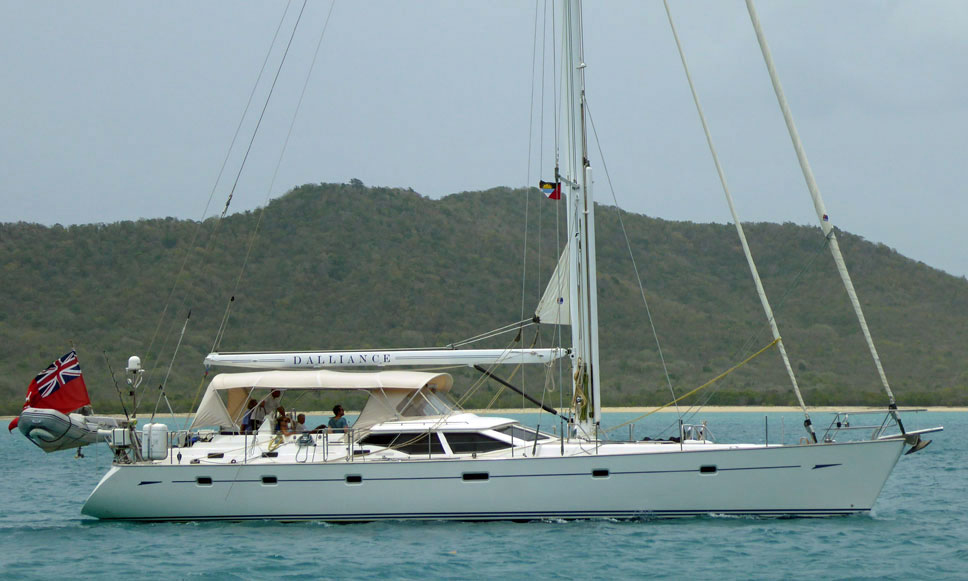- Home
- Sailboats 50'-55'
- Irwin 52
The Irwin 52 Sailboat
Specs & Key Performance Indicators
The Irwin 52, a centre-cockpit staysail ketch, was designed by Ted Irwin and built in the USA by Irwin Yachts.
Published Specification for the Irwin 52
Keel & Rudder Configuration: Fin keel and a skeg-hung rudder.
Hull Material:
Fibreglass (GRP).
Length Overall*: 15.85 metres (52'0").
Waterline Length*:
12.50 metres (41'0").
Beam*: 4.42 metres (14'6").
Draft*: 2.01 metres (6'7").
Rig Type: Staysail Ketch (see note)
Displacement*: 18,144 kg (40,000 lbs).
Ballast*: 6,804 kg (15,000 lbs).
Sail Area*: 109.62 m² (1180 ft²).
Water Tank Capacity: Approximately 757 litres (200 US gallons).
Fuel Tank Capacity: Approximately 568 litres (150 US gallons).
Hull Speed: Approximately 9.03 knots.
Designer: Ted Irwin.
Builder: Irwin Yachts.
Year First Built: 1976
Year Last Built: 1985
Number Built: The exact number built is not consistently published across sources, but the model was produced for nearly a decade.
* Used to derive the design ratios referred to later in this article - here's how they're calculated...
Note: Unlike a 'normal' ketch, on a staysail ketch there is an inner forestay supporting a staysail (or inner jib) between the mainmast and the headstay. This configuration allows for more versatile sail combinations, particularly useful for offshore cruising and heavy weather, as the sail area can be broken down into smaller, more manageable units.
Design Options & Alternative/Later Versions
Design Options: The Irwin 52 was primarily offered as a ketch. There is no readily available information indicating that significant shallow draft options were widely offered directly from the factory for this model; the most common draft is 2.01 metres (6'7"). Irwin Yachts were known for offering somewhat flexible or various interior layouts, especially in their larger models, with variations in the arrangement of berths, the size of the galley, and the number of heads.
Alternative Versions: While not explicitly termed "alternative versions," Irwin Yachts would often introduce minor refinements or updated finishes throughout a production run. However, the core design of the Irwin 52 (hull, keel, and rig type) remained consistent as the ketch-rigged, fin-keel vessel.
Later Versions: There were no direct later versions or successor models specifically called "Irwin 52" that were fundamentally different in design from the original 1976-1985 production run. After its production ceased, Irwin Yachts produced other large cruising yachts, but these were new designs with different model numbers.
Sail Areas & Rig Dimensions
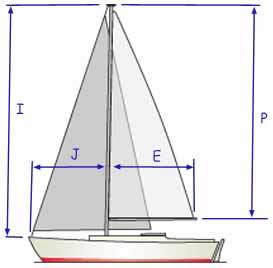 Sail Areas & Rig Dimensions
Sail Areas & Rig DimensionsSail Areas
Given its ketch rig, the Irwin 52 typically had three primary sails:
- Main Sail Area: Approximately 46.45 m² (500 ft²).
- Mizzen Sail Area: Approximately 13.94 m² (150 ft²).
- 100% Foretriangle Sail Area (Jib/Genoa): Approximately 49.23 m² (530 ft²).
- Staysail Area: While not explicitly listed, a typical staysail for a yacht of this size and rig would be in the range of 18.58 - 27.87 m² (200 - 300 ft²).
Please note these are approximate values, and the exact areas could vary slightly based on specific sailmakers or year of build.
Rig Dimensions
For the ketch rig of the Irwin 52, the rig dimensions are:
- I (Foretriangle Height): 18.75 metres (61'6").
- J (Foretriangle Base): 5.36 metres (17'7").
- P (Mainsail Luff Length): 16.46 metres (54'0").
- E (Mainsail Foot Length): 4.27 metres (14'0").
Additionally, for a ketch, mizzen dimensions are relevant:
- P2 (Mizzen Luff Length): 9.60 metres (31'6").
- E2 (Mizzen Foot Length): 2.74 metres (9'0").
Published Design Ratios
The Key Performance Indicators (KPIs)
The key design ratios for the Irwin 52 are:
- Sail Area/Displacement (SA/D) Ratio: 16.71
- Displacement/Length (D/L) Ratio: 248.88
- Ballast/Displacement Ratio: 37.5%
- Capsize Ratio: 1.71
- Motion Comfort Ratio: 42.22
Theoretical Sailing Characteristics
The design ratios offer a theoretical glimpse into how the Irwin 52 might perform and feel under sail:
- Sail Area/Displacement (SA/D) Ratio: 16.71 This ratio indicates the boat's potential for speed in light air. A ratio around 16-18 generally suggests a moderate performer. The Irwin 52 is not designed as a racing boat, but this ratio indicates it should move reasonably well in light to moderate breezes without being sluggish. It suggests a balance between power and stability for a cruising yacht of its size.
- Displacement/Length (D/L) Ratio: 248.88 This ratio classifies the boat's "heaviness" relative to its length. A D/L ratio between 200 and 300 typically categorises a yacht as a medium displacement cruiser. This means the Irwin 52 is designed for comfortable, stable offshore cruising rather than light-footed speed. It implies good carrying capacity for stores, fuel, and water, and a motion that will be less abrupt in a seaway compared to lighter displacement vessels. This ratio aligns with its role as a bluewater cruiser.
- Ballast/Displacement Ratio: 37.5% This percentage indicates the proportion of the boat's total weight dedicated to ballast, which provides stability. A ratio of 37.5% is respectable for a cruising yacht. It suggests that the Irwin 52 has a good amount of lead (or other ballast material) low in its keel, contributing to its stability and ability to carry its sail plan effectively, particularly in stronger winds. This contributes to a stiffer, more comfortable ride.
- Capsize Ratio: 1.71 The capsize ratio is a measure of a monohull's stability in rough seas, particularly its resistance to capsizing. A ratio of 2.0 or less is generally considered safer for offshore cruising. The Irwin 52's ratio of 1.71 indicates it has a high degree of initial stability and is considered very resistant to capsize in typical offshore conditions. This is a reassuring figure for extended voyages and heavy weather.
- Motion Comfort Ratio: 42.22 This ratio attempts to quantify how comfortable the motion of a boat will be in a seaway. Higher numbers generally indicate a more comfortable, slower pitching and rolling motion. A ratio of 42.22 is quite high, placing the Irwin 52 firmly in the category of a very comfortable offshore cruiser. This suggests it will have a gentle, deliberate motion, reducing the likelihood of seasickness and making long passages more bearable for the crew, rather than a quick, jerky motion.
In summary, the design ratios collectively describe the Irwin 52 as a stout, stable, and comfortable offshore cruising yacht. It is designed for steady progress and crew comfort over outright speed, capable of handling various sea conditions with a reassuring motion. Its ketch rig further enhances its versatility for sail plan management in different wind strengths.
But the Design Ratios Don't Tell the Whole Story...
While design ratios offer valuable insights, they have several significant limitations when used to define a sailboat's sailing characteristics in detail:
- Simplification and Generalisation: Ratios are based on a few fundamental dimensions and simplify the complex hydrodynamics and aerodynamics of a sailboat. They provide a broad brushstroke picture but cannot capture the nuances of hull shape, keel profile, rudder design, rig geometry beyond basic measurements, or weight distribution.
- Ignores Hull Shape and Appendages: The type and efficiency of the keel and rudder significantly impact manoeuvrability, upwind performance, and tracking. Ratios don't differentiate these critical aspects. The actual wetted surface area of the hull and appendages (which creates drag) is not directly captured by these ratios.
- Doesn't Account for Rig Design and Sail Plan Flexibility: The precise location of the sail plan's centre of effort relative to the hull's centre of lateral resistance is crucial for helm balance. Ratios only consider sail area, not the efficiency of the sails or the ability to trim them for optimal shape. The ratios also don't delve into the specifics of mast construction or rigging, which affect performance and ease of handling.
- Ignores Performance in Varying Conditions: Ratios are static numbers and do not predict a boat's behaviour in different wind strengths or sea states. They don't quantify a boat's ability to point high into the wind or its speed downwind, which are influenced by keel design, hull form, and sail shape.
- Crew Skill and Experience: The actual sailing characteristics are heavily influenced by the crew's skill and experience. A well-sailed boat can outperform a poorly-sailed one, even with theoretically less favourable ratios.
- Loading Conditions: Ratios are typically calculated for a light or design displacement. However, the performance and characteristics of a cruising boat like the Irwin 52 can change significantly when fully loaded with provisions, fuel, water, and gear for a long voyage.
- Subjectivity of "Comfort" and "Performance": While the motion comfort ratio attempts to quantify comfort, the perception of comfort and performance is ultimately subjective and varies among sailors.
In conclusion, design ratios are excellent tools for initial screening and comparison, providing a quick, theoretical understanding of a sailboat's general type and potential characteristics. However, they should not be used as the sole determinant of a boat's actual sailing performance or comfort.
More Specs & Key Performance Indicators for Popular Cruising Boats
Recent Articles
-
Hans Christian 43: Classic Bluewater Cruiser & Liveaboard Sailboat
Dec 10, 25 04:37 AM
Explore the Hans Christian 43: a legendary heavy-displacement, long-keel sailboat. Read our in-depth review of its specs, design ratios, and suitability for offshore cruising and living aboard. -
Planning Your Sailboat Liveaboard Lifestyle: An Ocean Sailor's Guide
Dec 06, 25 05:18 AM
Seasoned sailors share their methodical risk analysis for planning a secure Sailboat Liveaboard Lifestyle, covering financial, property, and relationship risks. -
Marine Cabin Heaters: The Expert’s Guide to Comfort & Safety at Sea
Dec 05, 25 06:52 AM
Choose the best Marine Cabin Heaters for your vessel. Expert advice on diesel, paraffin, and hot water systems for year-round cruising comfort.

